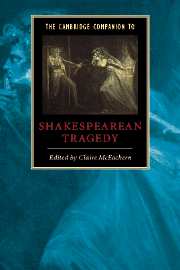Book contents
- Frontmatter
- 1 What is a Shakespearean tragedy?
- 2 The language of tragedy
- 3 Tragedy in Shakespeare’s career
- 4 Shakespearean tragedy printed and performed
- 5 Religion and Shakespearean tragedy
- 6 Tragedy and political authority
- 7 Gender and family
- 8 The tragic subject and its passions
- 9 Tragedies of revenge and ambition
- 10 Shakespeare’s tragedies of love
- 11 Shakespeare’s classical tragedies
- 12 The critical reception of Shakespeare’s tragedies
- 13 Antony and Cleopatra in the theatre
- Select bibliography
- Index
- Series List
5 - Religion and Shakespearean tragedy
Published online by Cambridge University Press: 28 May 2006
- Frontmatter
- 1 What is a Shakespearean tragedy?
- 2 The language of tragedy
- 3 Tragedy in Shakespeare’s career
- 4 Shakespearean tragedy printed and performed
- 5 Religion and Shakespearean tragedy
- 6 Tragedy and political authority
- 7 Gender and family
- 8 The tragic subject and its passions
- 9 Tragedies of revenge and ambition
- 10 Shakespeare’s tragedies of love
- 11 Shakespeare’s classical tragedies
- 12 The critical reception of Shakespeare’s tragedies
- 13 Antony and Cleopatra in the theatre
- Select bibliography
- Index
- Series List
Summary
Shortly after Elizabeth Tudor became England's queen in November 1558, the Acts of Supremacy and Uniformity were passed, effectively outlawing the practice of Roman Catholicism in England and making Elizabeth I head of the Church of England. By establishing Protestantism as the official state religion, Elizabeth hoped to put an end to the religious conflicts that had divided the English people and disrupted the realm ever since her father, Henry VIII, defied the Pope by divorcing Catherine of Aragon in 1534. In what is known as the Elizabethan settlement, she reversed the policies of her Catholic half-sister Mary I, who reigned from 1553 to 1558. Mary's marriage to Philip of Spain had forged an alliance between England and the most powerful Roman Catholic country on the continent. As queen she had attempted to return England to the Roman Catholic faith after a period of intense reform activity that occurred during the six-year reign of Mary and Elizabeth's younger half-brother, Edward VI (1547-53). With the Elizabethan settlement England became a predominantly Protestant country after many turbulent years of religious strife.
Five and a half years after Elizabeth’s ascension to the throne, William Shakespeare was born in Stratford. England’s most illustrious playwright thus belonged to the first generation of English people who lived their entire lives in an officially Protestant country, required by law to practise the established state religion.
- Type
- Chapter
- Information
- The Cambridge Companion to Shakespearean Tragedy , pp. 86 - 102Publisher: Cambridge University PressPrint publication year: 2003

